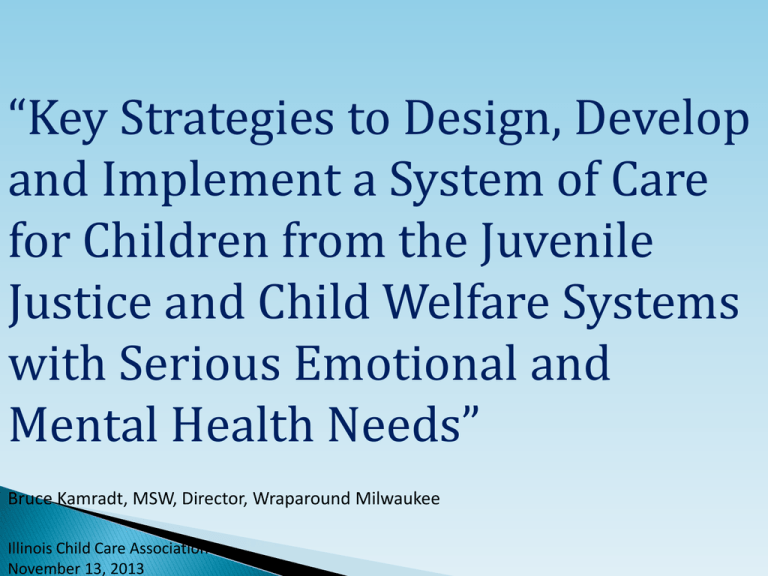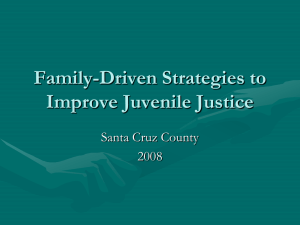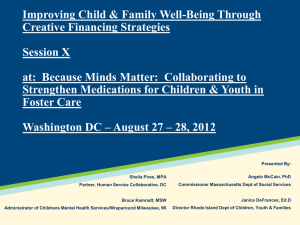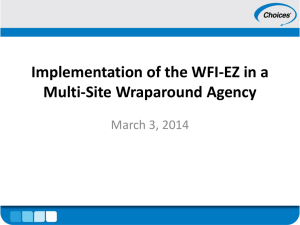
“Key Strategies to Design, Develop
and Implement a System of Care
for Children from the Juvenile
Justice and Child Welfare Systems
with Serious Emotional and
Mental Health Needs”
Bruce Kamradt, MSW, Director, Wraparound Milwaukee
Illinois Child Care Association
November 13, 2013
Created in 1995, it is a unique system of care for
Milwaukee County children & adolescents with
serious emotional, mental health and behavioral
needs that cross child serving systems (e.g. Mental
health, juvenile justice, child welfare) who are at
imminent risk of institutional type placements
1,500 youth/families served (1050 daily census)
Operated by Milwaukee County government as a
unique Care Management Entity (CME) under the
1915a provision of Social Security Act, it acts as a
type of behavioral health HMO
Pools funds across child serving systems ($51
million for 2013) to increase flexibility and
availability of funding – Wraparound Milwaukee is
single payer
One service plan and one care manager
47% of youth served are from juvenile justice
system and 25% are court-ordered from child
welfare system.
2009—Named by Harvard University—Kennedy
School of Government as Best Innovation in
American Government
Over utilization of out of home care for juvenile
justice and child welfare youth including
group/residential treatment, juvenile correctional
placements, and psychiatric in-patient care – Too
many kids being placed and for too long
High cost of out of home care expenditures was
causing serious deficits in juvenile justice/child
welfare budget in Milwaukee County
Poor outcomes for youth coming out of
institutional placements concerned court,
advocates and juvenile justice/child welfare
officials
4
Youth must meet the State eligibility
definition under the Medicaid Program
DSM-IV diagnosis
Functional or psychiatric impairment
Condition that is likely to persist for a year or
more
Involvement in two or more child serving
systems i.e. mental health, Child Welfare,
Juvenile Justice or special education
At immediate risk of institutionalization in a
residential treatment center, psychiatric hospital
or juvenile correctional facility
60% of families under U.S. federal poverty level
70% boys
Average age 13.5; 11.0 for voluntary REACH
program
67% African American, 23% Caucasian, 9 %
Hispanic
Major DSM-IV Diagnosis
◦
◦
◦
◦
◦
◦
60% Conduct disorder/oppositional defiant
50% Depressive disorders
40% Attention deficit
30% Substance abuse
30% Learning /developmental disabilities
8% Psychotic disorders
6
Regular wraparound – youth under a child welfare
order or adjudicated delinquent youth with serious
emotional disturbance (SED) at risk of placement in
a psychiatric impatient hospital , residential
treatment center or juvenile correctional placement
– 610 youth
FOCUS – youth with SED committed to the State
Dept. of Corrections with “stayed order” – 40 youth
Re-Entry – youth with SED being transitioned out of
a state juvenile correctional facility – 25 youth
7
REACH – non-adjudicated SED youth and their
families who are at risk of imminent placement in a
group home, residential treatment center,
psychiatric hospital who have had contact with two
or more child serving systems – 350
children/families
Healthy Transitions – 17 to 24 year old, young
adults with SED transitioning out of foster care
settings – 75 young adults
8
Family Directed Care – “Families needed to be seen
as the solution to meeting their children’s needs
and not the problem”
Strength-Based Care – “Needed to build on child
and family strengths and resources and not focus
on their perceived deficits”
Individualized Care – “Every child and family is
unique and deserves a care plan that addresses
their unique needs and is tailored to meet those
needs – categorical approaches don’t work”
Community-Based Care – “Services are usually more
effective when delivered in the child’s own home
and community versus institutional settings”
Coordinated Care Across Serving Systems –
“Coordinated care across child serving systems
works better than fragmented care – One Family –
One Plan”
Culturally Competency in Service Provision “Respect and understanding for cultural differences
is paramount to effectively work with families”
Unconditional Responses – “ We never can give up –
plans fail, not people”
Ten Critical Strategies for Designing, Developing and
Implementing Systems of Care
•An effective and logical administrative structure
•A blended financing model
•Strong collaboration across child serving systems
•Strong family and youth partnerships
•Ability to provide individualized, tailored care to participants
Ten Critical Strategies for Designing, Developing and
Implementing Systems of Care
•Availability of mobile crisis services and crisis supports 24/7
•A high quality and diverse Provider Network
•A comprehensive array of mental health and support services that are evidence-informed
•Ability to create a good quality assurance, quality improvements and outcomes measurement
program
• Effective Information Technology System
1. An effective and logical administrative structure
•It is best to create a separate administrative structure for the day-to-day operation of the
system of care, called a Care Management Entity (CME)
What is a Care Management Entity (CME)?
•An organizational entity that serves as the “locus of accountability” for defined
populations of youth with complex challenges across service systems
•Is accountable for improving the quality, outcomes and cost of care for
historically high-cost/poor outcomes populations
•In Milwaukee County, most youth with serious emotional mental health needs at
risk of institutional placement served in the juvenile justice and child welfare
systems are referred to the Wraparound Milwaukee CME
Administration
Program oversight
Enrollment
Finance – claims
processing and payment
of providers
Quality assurance/quality
management including
utilization review
Evaluation
Information technology
Contracting/procurement
Public relations
Liaison with courts
Dispute resolution
Programmatic
Assessment
Care Coordination
Provider Network
Crisis services
Medical/clinical oversight
Family Advocacy
Training/consultation
15
2. A blended funding system
•It is desirable for child serving systems to pool, or “blend” funds to create a more sufficient and
flexible funding source
•A single payor system is more efficient than having each child serving system funding care
separately for the same children
CHILD WELFARE
$131.00 Case Rate
(Budget for Institutional
Care for CHIPS Children)
10.0M
JUVENILE JUSTICE
(Funds Budgeted for
Residential Treatment and
Juvenile Corrections Placements)
10.0M
MEDICAID CAPITATION
(1923 per Month per Enrollee)
23.0M
CARE MANAGEMENT ORGANIZATION
(CMO)
$51.0 M
FAMILIES UNITED
$475,000
PLAN OF CARE
OR
FUTURES PLAN
•CRISIS BILLING
•HTI GRANT
•HMO COMMERCIAL INSUR
8.0 M
WRAPAROUND MILWAUKEE
CHILD & FAMILY TEAM
OR
TRANSITION TEAM
MENTAL HEALTH
Child Welfare
Medicaid
Alternative to out-of-home
care
high costs/poor outcomes
Alternative to IP/ER-high
cost
System of Care
Alternative to
Residential &
Correctional placements
Juvenile Justice
Alternative to DayTreatment costs
Special Education
With help of managed care consultant, we
costed out potential costs of caring for
residential treatment youth in the community
including shorter RTC stays, anticipated service
needs, etc.
Proposed $3300 per month case rate versus
$5600 average cost of RTC placement (1996)
18 month period of time to enroll all existing
youth in residential treatment plus all newly
identified youth needing RTC level of care
MHD’s Wraparound Milwaukee Program would
assume fiscal risk
Dane County (Madison) and Milwaukee County began
negotiating with Medicaid in 1995 to create “behavioral
health carve-outs” in the two most populous Wisconsin
counties proposed model would include access to child
welfare/juvenile justice funds though this was not absolutely
required under waiver
Used 1915(a) provision of Social Security Act to create a
voluntary managed care program for this defined group of
youth
Ability to access child welfare/juvenile justice funds plus
potential of reducing RTC placements offered Medicaid
potential cost savings in reduced acute inpatient psychiatric
bed days
Actual Analysis of costs of these RTC/SED youth performed
and Wraparound Milwaukee (Milwaukee County) offered 95%
of per child per month cost and would assume fiscal risk
3. Strong collaboration across child serving systems
CHALLENGE
1. Language Differences
“Mental Health Jargon vs. Court Jargon”
◦ Cross Training Needs
◦ Share Literature On Wraparound
2.
Role Definition: “Who’s in Charge?”
◦ Family Driven / Philosophy
◦ Team Development Training
◦ Job Shadowing
CHALLENGE
3. Information Sharing Between Systems
◦ Set up a Common Data Base for Shared Access to
Information
◦ Share Org. Charts / Phone Lists
◦ Share Paperwork Responsibility ie: Court Letters,
Reports, etc.
◦ Promote Flexibility in Schedules to Support
Attendance in Meetings
4. Addressing Issues of Community Safety
◦ Document Safety Plans
◦ Develop Protocol for High Risk Kids
◦ Demonstrate Adherence to Court Orders
CHALLENGE
5. Maintaining Investment from Stakeholders
◦ Invest in Relationships with Partners in Collaboration
ie: Judges, DA’s, Probation, etc.
◦ Track & Provide Meaningful Outcomes
6.
Sharing Value Base
◦ Infuse Values into all Meetings, Trainings &
Workshops
◦ Share Documentation and Include Parents in as Many
Meetings as Possible
Having a written memorandum of
understanding (MOU) for key
stakeholders/funders
Define roles to avoid “Turf Issues”
Financial arrangements
Reporting requirements
Creating a conflict resolution protocol
Care Coordinator &
Bureau Worker
Care Coordinator &
Probation Officer
Care Coordinator
Supervisor & Bureau
Supervisor
Care Coordinator
Supervisor & Probation
Supervisor
Wraparound Milwaukee
Liaison & Bureau Section
Manager
Wraparound Milwaukee
Liaison & Probation
Program Manager
Wraparound Milwaukee
Director & Director
Delinquency Services or
Director Bureau of
Milwaukee Child Welfare
Developing a standard curriculum for training
of all staff
Creating and disseminating meaningful
program, fiscal and clinical outcomes
Making available a single information system
for improved data sharing
Delinquency & court services uses Synthesis for their IT
needs
Standardizing flexible court orders
Each system’s role with child/family is specifically
written into court order
Child Welfare workers, Probation and Wraparound
Milwaukee care coordinators share court duties
regarding reports, filing of legal documents, etc.
Participating on Child Welfare & Juvenile
Justice committees, workgroups, councils, e
and expecting Child Welfare & Juvenile
Justice staff to participate in plan of care
and other wraparound meetings.
Developing a coordinating Committee of Key
Stakeholders.
Advisory committee to the Wraparound Milwaukee
Program
Consists of representatives from key child serving
agencies i.e. Child Welfare, Juvenile Justice, schools,
Medicaid, etc.
Judicial representation
Families/advocates
Providers from network
CEO’s from 8 care coordination agencies
Advise Wraparound management on program,
fiscal, and clinical issues, etc.; review QA/QI and
evaluation studies; review training/education needs
of program, etc.
4. Strong Family and Youth Partnerships
•Families want “Voice, Choice and Ownership” in decisions related to their children and families
need to be actively engaged in directing the care of these children
•Systems of care utilize Family Advocacy agencies to provide 1:1 advocacy and other supports
for families
•Developing a Youth Council, Clubhouse Model, Young Adult Peer Specialists and other
approaches can provide positive community experiences for youth
•Families and Youth need to be invited to participate on all agency committees, councils,
training and staff development and other activities
Orientations
Advocacy
on Child &
Family
Team
Crisis
Intervention
Serve on
Wrap
Committees
/Work
Groups
Relaxation
and Support
Groups
Families
United
Recruitment
/Training of
Families
Family
Events
Educational
Advocacy
Youth
Council/Yout
h Advocacy
Assist
Families in
Court
5. Ability to provide individualized, tailored care to
participants
•It is best to utilize a family driven process called “wraparound approach” where a care plan is
created unique to each family and utilizing the strengths of the Child and Family Team to meet
their needs and reach desired outcomes
•Child and Family Teams, made up of the family, friends, and providers chosen by the family,
create the individualized tailored care plan
•Care Coordinators facilitate coordinated service teams and help the family identify and arrange
for needed services
•Care Coordinators should work with no more than eight families -The goal is to have “One Family – One Plan”
Wraparound is a family driven process
where a plan unique to the family is created
utilizing the strengths and supports of the
Child and Family to meet their needs and
reach their desired outcomes
In Wraparound, Child and Family teams are
formed, made up of the family, friends &
providers to create an individualized tailored
care plan
•
•
•
•
•
•
•
•
Teams are facilitated by a Care Coordinator
whose roles and responsibilities include:
Home visits (weekly)
Monthly Team Meetings
Plan of Care Meetings, every 60 – 90 days
Collaborating with System Partners
Court appearances when indicated
School meetings as needed
Authorizing and arranging supports and
services
Ongoing monitoring of the Plan of Care and
service provision
Strengths
Community
Based
System
Integration
Unconditional
Care
Normalization
Values &
Principles
Family
Centered
Cultural
Competency
Refinancing
Collaboration
Needs
Driven
Agencies provide a welcoming environment
Staff use family friendly language
Information is shared with permission only
and on a need to Know basis
Meetings are not held without the youth
and family present
Brochures, documents, spaces are sought
out, reviewed and approved by the families
they will be serving
Staff embrace and adhere to strength based
language in conversation and
documentation
Staff are taught to reframe in a meaningful
way that leads to hope for the families and
realistic planning
Creative resource development and
planning is encouraged and supported
Agencies respond to the unique needs of
families in their communities
Staff are trained to listen to needs rather than
diagnoses and deficits only
Plans of care are developed that are
responsive to the individualized needs of
youth and families rather than service driven
based on what we have and know
•
•
•
Agencies demonstrate diversity in their hiring
practices, policies and training
All committees, trainings and events have
youth and family input, membership and
participation
Family norms and culture are sought out,
embraced and incorporated into the family’s
plan for the success of the family
Money flows in the system of care to support needs
at the community and individual family level
Agencies are imbedded in the communities where the
families live and/or are easily accessible.
Operating hours of business, meetings, trainings and
events are responsive to families’ schedules
Families get what they need rather than what we have
Community Stakeholders are easily mobilized to take
action in times of need
Agencies are at the table to break down barriers
and partner in an effective and sustainable way
on behalf of families
A single care plan format has been developed to
decrease confusion, avoid duplication of efforts
or dollars and enhance coordination for the best
care of youth and families
Agencies are not permitted to kick kids and
families out of the very programs established
to meet their needs.
Blame the plan if it isn’t working, not the
family
Develop methods to hold everyone
accountable for follow through on promised
actions in committees as well as plan of care
meetings
Develop methods to measure outcomes and
remain outcome driven
6. Availability of mobile crisis services and crisis
supports 24/7
•Crisis Safety Plans need to be created for all youth with serious emotional and mental health
needs
•Mobile Crisis Teams need to provide crisis intervention services, 24/7 and see the child and
family in the community wherever the crisis occurs, whether at home, school or other location
•It is advantageous to create an array of crisis stabilization services such as utilizing crisis 1:1
stabilizers to provide follow-up support to families, teachers and others and can implement
crisis/safety plans to prevent re-occurrence of the crisis and/or teach strategies to the family to
more effectively deal with future crisis
Crisis Teams (24/7)
Crisis Plans
Crisis Beds in foster, group homes and residential
centers
Crisis 1:1 Stabilizers
Preferred Inpatient Providers
7. A high quality and diverse Provider Network
•Rather than contracting for a more limited array of programs, Wraparound Milwaukee created
a network of nearly 200 mental health and social service agencies to provide a broader array of
services – whatever the family needs
•Providers are paid on a fee-for-service basis and emphasis is put on quality and achieving
positive outcomes
•Families need to have a choice of service providers rather than be assigned to a specific agency
8. A Comprehensive Array of Mental Health and
Support Services
•To individualize care based on needs, systems of care need a broad service array of mental
health and supportive – “one size or service does not fit all” services available to children and
families
•Systems of care need both formal “paid services” as well as informal or “unpaid services”
Supportive Services
Service Coordination
Mentors
Care coordination
Crisis 1:1 stabilizer
Respite
Tutor
Crisis/planned respite
Parent/family aide
Residential respite
Life coach – independent
living
Discretionary
Medication management
Employment preparation and
placement
Clothing
Day treatment
Job – internship
Behavioral & Clinical
Services
Crisis intervention
Individual therapy
Intensive in-home therapy
Evaluation
Substance abuse therapy
(individual and group)
Special therapy
(i.e.Placement
behavioral management
Services
team)
Acute hospitalization
Other Supportive
Flex Funds
Food/groceries
Housing assistance
Child care
Camps
Furniture, appliances
Foster home and treatment
foster home
After school
YMCA membership
Suspension accountability
Educational expenses
Group home care
Transportation
Residential treatment
Interpretive services
Crisis/residential, group care,
treatment foster care
Equine therapy
Supported independent living
Consultation with other
professionals
47
9. Ability to create a good quality assurance/quality
improvement and outcomes measurement
program
•Policies and mechanisms should be put in place to ensure that care and services are being
provided consistent with program expectations
•Outcomes to be measured should be meaningful to stakeholders
10. Effective Information Technology Systems
•One electronic health record and single information system should link all Care Coordinators,
Service Providers and System Partners
•Create immediate access for system partners, care coordinators and managers to information
including demographic and enrollment information, care plans, services authorized, vendor lists,
program notes as well as utilization data, medical information and other reports should be
available to support system
1. QA/QI Workplan
2. Policies and Procedures
3. Auditing
Plans of Care
b. Progress Notes
c. Charts
d. Provider Network
a.
Quality
Assurance and
Quality
Improvement
4. Family Satisfaction Surveys
Care Coordinator
b. Provider
c. Out of Home
a.
5. Complaint/Grievance
/Critical Incident Process
6. Outcome Evaluation
7. Utilization Review
8. Agency Performance Reports
a.
Care Coordination monitoring
Outcomes currently being measured include
programmatic, fiscal, clinical, public safety, child
permanency and consumer satisfaction
Programmatically – the average daily residential treatment
population has dropped from 375 youth to 80 youth, inpatient
psychiatric days from 5000 to under 500 days per year
Fiscally – the averages cost for a child/family in Wraparound is
about $3,400 per month (2013)versus nearly $9,500 per
month for a residential treatment placement, nearly $9000 per
month for a correctional placement or well over $10,000 for a
7-day hospital stay
Clinically – children function better at home, school and in the
community based on administration of nationally normed
measures such as the CBCL (Achenbach) used at the time of
enrollment and discharge
Public Safety – recidivism rates for delinquents are low (15.2%)
for youth in the program for at least one year and even lower
(6.7%) for high risk offenders including juvenile sex offenders
(this is considerably under national standards)
Child Permanence – 80% of youth achieve permanency, i.e.,
return to parents, relatives, adoptive resources or subsidized
guardianship upon leaving Wraparound
Family Satisfaction – families surveyed upon completing
Wraparound (average 18 months) gave the program a rating of
4.4 out of 5 points in terms of their perception of the progress
their child made while in the program
Overall recidivism rate for Wraparound
Milwaukee
(Oct 2009 – June 2012)
Re-offending rate for high risk (juvenile
delinquent) youth in Wraparound Milwaukee
Statistically significant
improvement in functioning on
Child Behavioral Checklist (CBCL),
Youth Self Report (YSR). Overall,
85% of youth at disenrollment
have an improved level of
functioning on the CBCL.
40% increase in school attendance
from time of enrollment to
disenrollment. Youth attended
87% of school days in 2012.
85% of youth achieved
permanency plan of return home,
relative placement or independent
living at time of discharge from
Wraparound Milwaukee
Cost Effectiveness
Wraparound Milwaukee vs. Institutional Placements
Over Past Five Years
(average monthly cost of service)
Wraparound Milwaukee’s Impact on Reducing Utilization of State Correctional Placements and Costs Over Past Six Years*
*Wraparound Milwaukee serves 40% of youth in Milwaukee County on probation and most of youths at immediate risk of residential treatment/correctional
placement.












